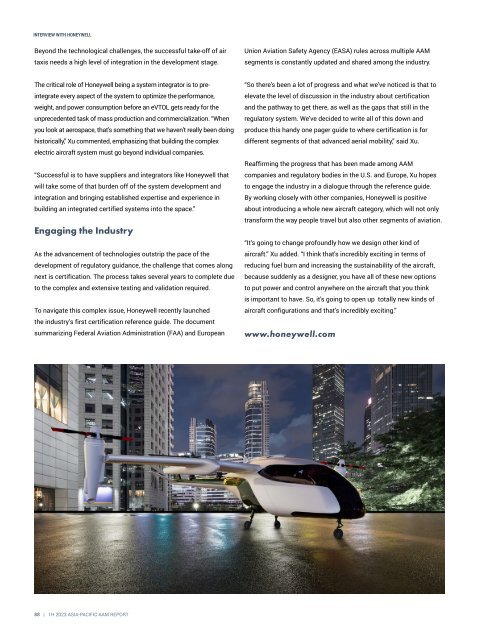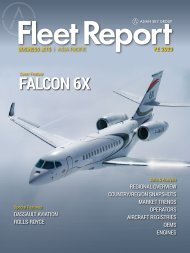Asia-Pacific AAM Report 1H 2023
You also want an ePaper? Increase the reach of your titles
YUMPU automatically turns print PDFs into web optimized ePapers that Google loves.
INTERVIEW WITH HONEYWELL<br />
Beyond the technological challenges, the successful take-off of air<br />
taxis needs a high level of integration in the development stage.<br />
Union Aviation Safety Agency (EASA) rules across multiple <strong>AAM</strong><br />
segments is constantly updated and shared among the industry.<br />
The critical role of Honeywell being a system integrator is to preintegrate<br />
every aspect of the system to optimize the performance,<br />
weight, and power consumption before an eVTOL gets ready for the<br />
unprecedented task of mass production and commercialization. “When<br />
you look at aerospace, that's something that we haven't really been doing<br />
historically,” Xu commented, emphasizing that building the complex<br />
electric aircraft system must go beyond individual companies.<br />
“Successful is to have suppliers and integrators like Honeywell that<br />
will take some of that burden off of the system development and<br />
integration and bringing established expertise and experience in<br />
building an integrated certified systems into the space.”<br />
Engaging the Industry<br />
As the advancement of technologies outstrip the pace of the<br />
development of regulatory guidance, the challenge that comes along<br />
next is certification. The process takes several years to complete due<br />
to the complex and extensive testing and validation required.<br />
To navigate this complex issue, Honeywell recently launched<br />
the industry’s first certification reference guide. The document<br />
summarizing Federal Aviation Administration (FAA) and European<br />
“So there's been a lot of progress and what we've noticed is that to<br />
elevate the level of discussion in the industry about certification<br />
and the pathway to get there, as well as the gaps that still in the<br />
regulatory system. We've decided to write all of this down and<br />
produce this handy one pager guide to where certification is for<br />
different segments of that advanced aerial mobility,” said Xu.<br />
Reaffirming the progress that has been made among <strong>AAM</strong><br />
companies and regulatory bodies in the U.S. and Europe, Xu hopes<br />
to engage the industry in a dialogue through the reference guide.<br />
By working closely with other companies, Honeywell is positive<br />
about introducing a whole new aircraft category, which will not only<br />
transform the way people travel but also other segments of aviation.<br />
“It’s going to change profoundly how we design other kind of<br />
aircraft.” Xu added. “I think that's incredibly exciting in terms of<br />
reducing fuel burn and increasing the sustainability of the aircraft,<br />
because suddenly as a designer, you have all of these new options<br />
to put power and control anywhere on the aircraft that you think<br />
is important to have. So, it's going to open up totally new kinds of<br />
aircraft configurations and that's incredibly exciting.”<br />
www.honeywell.com<br />
88 | <strong>1H</strong> <strong>2023</strong> ASIA-PACIFIC <strong>AAM</strong> REPORT
















